The Operating Week Ahead: Week of October 27th, 2025
Task Reallocation, Organizational Flattening, and Leadership Velocity
New to Operating by John Brewton?
Check out these reader favorites:
Opening: The Paradox
Nearly one million American workers will lose their jobs in 2025. Yet the S&P 500 delivered its sixth consecutive quarter of net profit margins above the five-year average, reaching 12.8%. Companies eliminated 946,426 positions through September—the fifth-highest total in 36 years—while 87% of reporting firms beat earnings expectations.
This isa strategic recalibration at unprecedented velocity.
Target Corporation announced 1,800 corporate job cuts this week, its largest workforce reduction in a decade. Incoming CEO Michael Fiddelke was explicit about the rationale: “The complexity we’ve created over time has been holding us back. Too many layers and overlapping work have slowed decisions, making it harder to bring ideas to life”. This statement crystallizes the defining transformation of 2025—not cost-cutting disguised as strategy, but fundamental organizational redesign driven by technological capability and competitive necessity.
The thesis unifying this week’s signals: Task reallocation powered by AI automation, organizational flattening enabled by reduced coordination costs, and leadership velocity accelerated by structural simplification are converging to create adaptive capacity as the central competitive advantage. Companies mastering this triple transformation will compound advantages. Those treating it as a cost exercise will compound vulnerabilities.
Monthly comparison of announced job cuts in 2025 versus 2024, showing unprecedented volatility with March 2025 peak of 275,240 cuts
The Week That Was
The Organizational Complexity Tax
Target’s restructuring (affecting 8% of its global headquarters workforce) offers a window into the operational calculus reshaping corporate structures. The retailer’s announcement followed stagnant sales and operational inefficiencies that Fiddelke attributed directly to excessive organizational layers. The company established an “Enterprise Acceleration Office” to eliminate redundant roles and streamline decision-making.
This pattern extends far beyond retail. Accenture reduced headcount from 791,000 to 779,000 in just three months, shedding 11,000 positions tied to an $865 million restructuring program. CEO Julie Sweet was unambiguous: the company is “exiting people on a compressed timeline where reskilling is not a viable path for the skills we need”. Accenture now employs 77,000 professionals in AI and data—nearly double the number from two years prior—while simultaneously cutting roles that cannot rapidly transition to AI-enabled work.
The academic framework for understanding this shift comes from Acemoglu and Restrepo’s task-based labor model. Their research demonstrates that automation operates by substituting capital for labor in a widening range of tasks, creating both displacement effects (reduced labor demand in automated tasks) and productivity effects (reduced costs). Critically, the framework clarifies that the full impact depends on whether new tasks are created to reinstate labor demand.
Current data suggests both forces operating simultaneously but asymmetrically. Challenger, Gray & Christmas reports that “AI/Technology Update” accounts for 20,219 job cuts in 2025, with an additional 17,375 attributed directly to “Artificial Intelligence”. Combined, AI-related reductions represent 37,594 positions—a task displacement effect. Yet Accenture’s $5.1 billion in generative AI bookings (up from $3 billion the previous year) signals new task creation in AI implementation, data analytics, and system integration.
Major restructuring announcements in October 2025, led by Robert Bosch (13,000), Accenture (11,000), and Novo Nordisk (9,000)
Major restructuring announcements in October 2025, led by Robert Bosch (13,000), Accenture (11,000), and Novo Nordisk (9,000)
The restructuring rationale increasingly centers on coordination costs rather than labor costs. Lufthansa’s plan to eliminate 4,000 administrative jobs by 2030 explicitly cites “artificial intelligence, digitalization, and consolidating work among its member airlines”. This reflects research showing AI systems can reduce the need for coordination layers when they provide real-time visibility across business operations.
Organizational Flattening: From Hierarchy to Network
The structural implication of reduced coordination costs is organizational flattening. Gartner forecasts that through 2026, 20% of organizations will use AI to flatten their organizational structure, eliminating more than half of current middle management positions. This is observable in Fortune 500 companies today.
Pharmaceutical giant Moderna merged its technology and human resources departments into a single function led by a Chief People and Digital Technology Officer. The move, driven by partnership with OpenAI, reflects the reality that AI now handles tasks spanning both domains—from HR support queries to junior-level technical work. Traditional functional boundaries blur when AI coordination systems synthesize insights across expertise domains.
BCG research confirms this structural shift: “Teams are flattening as AI becomes embedded. Support-heavy roles like technical product managers, quality assurance engineers, and sales development representatives are shrinking as AI handles execution”. One tech leader interviewed by BCG described replacing “coordination layers with shared tools and copilots, phasing out certain coordination-heavy roles, such as technical product managers and product marketing managers, as their responsibilities are redistributed and supported by AI”.
The organizational design literature provides theoretical grounding. Recent comprehensive reviews identify four major approaches to organization design: configuration (fit between design features), control (mitigating delegation costs), channelization (directing attention and behavior), and coordination (integrating interdependent efforts). AI’s impact operates most powerfully on the coordination dimension—when systems can integrate information and identify conflicts across specialized nodes, hierarchical coordination mechanisms become redundant.
Research from Harvard’s Megaproject Delivery Centre offers a complementary perspective through its analysis of 10,000 papers on organizational design. The study identifies eight key decision dimensions influencing organizational structure, with “capability dependency” emerging as critical. When AI augments individual capability and reduces dependency on coordinative roles, organizational structures can flatten while maintaining—or improving—performance.
Analysis of stated reasons for 946,426 job cuts in 2025, revealing strategic restructuring rather than economic distress as primary driver
Analysis of stated reasons for 946,426 job cuts in 2025, revealing strategic restructuring rather than economic distress as primary driver
Leadership Velocity and the Tenure Paradox
The third force driving transformation is leadership velocity—the rate at which organizations cycle through strategic decision-makers and refresh leadership capabilities. Fortune 500 C-suite tenure data reveals a striking pattern: CEOs average 7.4 years in role, while COOs average just 3.2 years. This 4.2-year differential is intentional structural design.
The COO role increasingly functions as a high-velocity development position for CEO aspirants. Short tenure signals not instability but strategic succession planning. Organizations are compressing the timeline from operational leadership to strategic leadership, creating faster adaptation cycles. This pattern extends beyond the COO role—CHRO tenure declined from 5.5 years to 4.7 years between 2020 and 2024, while CIO and Chief Supply Chain Officer tenures increased by nearly a year.
The differential tenure patterns reveal strategic priorities. Roles directly impacted by digital transformation (CIO, Supply Chain) reward longevity and accumulated expertise. Roles focused on organizational redesign (CHRO, COO) optimize for fresh perspective and rapid iteration. The result is selective velocity—fast cycling where adaptation matters most, stability where deep expertise compounds.
Spencer Stuart’s analysis shows 76% of CEOs and 79% of COOs are internally promoted, while only 43% of CIOs come from within. This inversion is rational: internal promotion for strategic roles ensures cultural continuity and relationship capital, while external hiring for technical roles imports updated capabilities and challenges organizational assumptions.
Research on courageous leadership offers insight into why velocity matters now. Harvard Business School Professor Ranjay Gulati’s analysis of 4,700 public companies across three recessions found that approximately 9% emerged stronger by simultaneously cutting costs thoughtfully while taking calculated risks to invest in growth. The differential factor was leadership courage—the willingness to take bold, risky action in uncertain environments.
Gulati identifies five strategies courageous leaders employ: creating positive narratives that reframe chaos as opportunity, building confidence through preparation and focusing on controllables, sizing up situations step-by-step rather than seeking perfect information, enlisting allies and critics, and practicing self-care and reframing. These capabilities cannot be learned through extended tenure in stable roles. They require exposure to volatility—precisely what shorter leadership cycles and cross-functional rotation provide.
C-suite tenure and internal promotion rates across Fortune 500 companies in 2025, revealing acceleration in COO turnover
This Week’s Essential Reading
The strategic signals this week align with analyses from leading business publications. These pieces provide complementary perspectives on transformation under uncertainty:
Leadership Under Pressure
“Now Is the Time for Courage” – Ranjay Gulati, Harvard Business Review
Empirical playbook for bold leadership during volatility, analyzing 4,700 companies across three recessions to identify what separates winners from casualties.
Organizational Transformation
“How Digital Integration Is Reconfiguring Value Chains” – Antonio Moreno, Harvard Business Review
Case-driven analysis of how automation and coordination systems fundamentally reshape industry economics and competitive positioning.“The battle to save Intel: How a great American company ended up in the fight of its life” – Geoff Colvin & Lila MacLellan, Fortune
Inside Intel’s existential restructuring, offering lessons for established firms navigating technological disruption and legacy complexity.
AI Implementation & Risk
“Addressing Gen AI’s Quality-Control Problem” – Thomke, Eisenhauer & Sahni, Harvard Business Review
Operational checklist for scaling generative AI without catastrophic quality failures—the execution complement to strategic vision.“Why AI Agents Are the Consulting Industry’s Next Hiring Frenzy” – The Information
Real-time documentation of task reallocation: consulting firms simultaneously cutting traditional roles and aggressively hiring AI specialists.
Market & Policy Context
“Why China is Winning the Trade War” – The Economist
Cover story examining U.S.-China rivalry’s impact on global supply chains and why adaptive capacity now determines competitive survival.
Weekend Reading
“He’s Baseball’s $325 Million Pitcher—and He Might Be Underpaid” – Jared Diamond, The Wall Street Journal
Yoshinobu Yamamoto’s record contract raises a provocative question about talent valuation: if star performers generate asymmetric returns, are we systematically underpricing elite capability? A fun exploration of labor economics that applies equally to your next executive hire.
Deep Analysis: The Task Reallocation Mechanism
The most significant development this week is not any single restructuring announcement but the strategic coherence emerging across announcements. Companies are not cutting randomly. They are systematically eliminating roles where AI demonstrates task-level substitution capability while simultaneously investing in roles requiring judgment, relationship management, and strategic synthesis.
Recent NBER research provides empirical validation. Hampole, Papanikolaou, Schmidt, and Seegmiller constructed measures of workers’ task-level exposure to AI from 2010 to 2023 using natural language processing. Their findings reveal three critical patterns:
First, tasks with higher AI exposure experience reduced labor demand. This is the displacement effect Acemoglu and Restrepo predicted. Occupations where many tasks face high AI exposure see aggregate employment decline.
Second, occupations with concentrated exposure in a few tasks experience employment increases. When AI automates specific high-volume tasks, workers reallocate effort to non-displaced tasks, raising productivity. Firms respond by increasing hiring in these occupations. This is task reallocation rather than wholesale displacement.
Third, productivity-driven employment increases occur across all occupations at AI-adopting firms. Even as specific tasks automate, overall labor demand at AI-enabled companies rises because productivity gains enable expansion.
Harvard research by Autor and Thompson adds nuance. The employment impact of task automation depends critically on which tasks within an occupation are automated. Automating low-expertise tasks (e.g., data entry in accounting) raises average expertise and wages in the occupation. Automating high-expertise tasks (e.g., inventory forecasting) lowers average expertise and wages. The distributional effects differ radically based on task composition.
Recent evidence suggests generative AI may automate entry-level cognitive work while complementing experienced workers. Brynjolfsson, Chandar, and Chen found employment decline for younger, less experienced workers in AI-exposed occupations alongside expansion for more experienced workers. Hosseini and Lichtinger confirmed this pattern using LinkedIn data—declining entry-level hiring and rising employment of experienced workers following AI adoption.
The mechanism appears to be that generative AI can mimic strategies learned from written educational materials (substituting for entry-level work) but cannot yet replicate tacit knowledge and judgment accumulated through experience (complementing senior work). This creates a hollowing of junior roles while increasing demand for seasoned judgment—precisely the pattern visible in Accenture’s restructuring.
The Triple Transformation framework showing how task reallocation, organizational flattening, and leadership velocity converge to create adaptive capacity
McKinsey’s research on organizational “superagency” provides the strategic synthesis. The consulting firm argues AI agents should act as collaborative partners that empower employees rather than simply replacing them. This enables workers to amplify impact through faster decisions and higher-quality outcomes. The concept extends Acemoglu’s framework by suggesting new tasks emerge not just from technological possibility but from strategic choice—organizations actively designing human-AI collaboration models.
This is why Target’s Fiddelke framed restructuring as removing complexity rather than reducing headcount. The strategic objective is not fewer people but different work. Eliminating coordination overhead frees capacity for strategic judgment, customer engagement, and innovation—tasks where human comparative advantage remains strong.
These forces are mutually reinforcing. Task reallocation reduces coordination needs, enabling flattening. Flattening accelerates decision cycles, creating demand for leadership velocity. Leadership velocity drives willingness to pursue aggressive task reallocation.
The result is adaptive capacity, the ability to rapidly reconfigure organizational resources, capabilities, and structures in response to technological and competitive shifts. Research on organizational design confirms adaptive capacity as the critical capability in volatile environments.
The Week Ahead: Navigation Guide
Strategic Principles for the Week
Principle 1: Differentiate Operational Excellence from Strategic Courage
Many companies will report strong operational metrics—cost control, margin expansion, operational efficiency. The differentiating question is strategic courage: which companies are making bold bets on new capabilities, new markets, or new business models despite uncertainty?
Fortune favors the brave in volatile periods. Companies that simultaneously cut costs thoughtfully and invest in growth emerge stronger. Listen for management teams articulating positive narratives about the future, demonstrating preparation and focus on controllables, and showing willingness to size up situations step-by-step rather than waiting for certainty.
Principle 2: Task-Level Analysis Over Role-Level Analysis
When companies announce restructuring or hiring, resist the temptation to interpret at the role level (e.g., “they’re cutting middle management”). Instead, apply task-based analysis: which specific tasks are being automated, augmented, or eliminated? Which new tasks are being created? How does the task composition change affect the strategic value of remaining roles?
Acemoglu-Restrepo framework clarifies that displacement and reinstatement operate at task granularity, not occupation granularity. A single role may contain tasks facing different automation exposure levels. The net employment effect depends on task reallocation within roles, not just role elimination.
Principle 3: Monetary Policy as Risk-Management Framing
The Fed’s decision and forward guidance should be interpreted through a risk-management lens rather than a mechanical forecasting lens. Recent research on monetary policy under uncertainty emphasizes that effective policy depends crucially on the specific source of uncertainty.
The Fed faces asymmetric risks: cutting too quickly could reignite inflation (especially given tariff pressures), while cutting too slowly could allow labor market deterioration to accelerate. Watch Powell’s press conference for emphasis on “data dependency” (suggesting cautious approach) versus “risk management” (suggesting willingness to act pre-emptively).
Federal Reserve research emphasizes that robust monetary policy strategies require being systematic yet flexible—predictable in framework but adaptive to unusual circumstances. The communication challenge is connecting current decisions to evolving outlooks while maintaining credibility. Alternative scenarios become important when risks are asymmetric rather than balanced.
Operating Principles
The week’s evidence suggests three analytical lenses for building organizational adaptive capacity:
Lens 1: Measure Task Exposure, Not Role Risk
Organizations should conduct task-level AI exposure assessments across all roles. Recent NBER research demonstrates that mean task exposure (the percentage of an occupation’s tasks that face high AI substitution risk) and exposure concentration (whether exposure is distributed across many tasks or concentrated in a few) matter.
High mean exposure with distributed risk signals displacement vulnerability. With high mean exposure and concentrated risk signals, reallocation of opportunity, workers can shift effort to non-exposed tasks. This distinction determines whether AI reduces or increases labor demand in specific occupations.
Practical application: Map each role to its constituent tasks. Assess AI substitution potential for each task. Calculate the mean exposure and exposure concentration. Roles with high mean exposure but low concentration are augmentation candidates (AI handles specific tasks, humans reallocate). Roles with high mean exposure and high concentration are displacement candidates (AI substitutes for most tasks).
Lens 2: Design for Flattening, Not Downsizing
Organizational flattening should be approached as coordination redesign rather than headcount reduction. The strategic objective is eliminating work that exists primarily to coordinate other work (status meetings, information aggregation, cross-functional alignment activities).
AI coordination systems can synthesize inputs from specialized expertise nodes, identify conflicts, and present decision options without hierarchical information flows. This enables moving from pyramidal authority structures to networked expertise structures.
Practical application: Audit coordination overhead across the organization. Identify which coordination activities add strategic value (building relationships, developing judgment, resolving value conflicts) versus operational value (information aggregation, status tracking, scheduling). Automate operational coordination. Preserve and enhance strategic coordination through cross-functional rotation, leadership development programs, and decision councils.
Lens 3: Optimize Tenure for Velocity and Depth Selectively
Leadership development should differentiate between roles requiring depth (accumulated expertise, relationship capital, institutional knowledge) and roles requiring velocity (fresh perspective, rapid adaptation, challenge to orthodoxy). Current Fortune 500 data shows this selective optimization already occurring—CIOs and supply chain leaders have longer tenure, while CHROs and COOs cycle faster.
The research on adaptive leadership confirms that collective adaptive capacity depends on both stability (for competence building and trust) and change (for perspective diversity and challenge to assumptions). Organizations need both simultaneously but in different structural locations.
Practical application: Identify which C-suite and senior leadership roles are transformation-critical versus domain-critical. Transformation-critical roles (CHRO, Chief Strategy Officer, business unit presidents) should optimize for 3-5 year tenure with planned rotation. Domain-critical roles (CIO, CFO, Chief Legal Officer) should optimize for 6-8 year tenure with deep expertise development. This creates selective velocity—rapid iteration where adaptation matters most, deep expertise where technical mastery compounds.
Conclusion: From Reorganization to Reinvention
The 946,426 job cuts announced through September 2025 are not primarily a cost story. They are a task reallocation story. Companies are systematically eliminating work that AI can now execute while creating demand for judgment, strategic synthesis, and adaptive leadership, work where human comparative advantage remains strong.
Target’s Fiddelke provided the definitive framing: “Too many layers and overlapping work have slowed decisions, making it harder to bring ideas to life”. The essential facts are these:
Task reallocation is accelerating: 37,594 AI-related job cuts alongside $5.1 billion in generative AI bookings at Accenture alone
Organizational structures are flattening: Gartner predicts 20% of organizations will eliminate more than half of middle management positions through 2026 using AI
Leadership velocity is increasing selectively: COO tenure of 3.2 years signals intentional, rapid development cycles
Profit margins are expanding: S&P 500 net margin of 12.8% exceeds five-year average despite restructuring costs
The convergence of these forces creates the adaptive capacity imperative. Organizations that master task-level reallocation, organizational flattening, and leadership velocity will compound competitive advantages through faster decision cycles, lower coordination costs, and superior talent deployment. Organizations that treat restructuring as a headcount exercise will eliminate capability without building agility.
The week ahead will reveal which companies understand this distinction. Listen for management teams articulating what work will expand, not just what roles will shrink. Watch for investments in AI-complementary capabilities, judgment development, strategic synthesis, customer relationship intensity. These signal understanding that the transformation is about task composition, not just cost structure.
Fortune favors the brave, not the cautious. Today, being brave is about the systematic application of task-based analysis, structural redesign, and leadership development to build organizations that adapt faster than markets shift. The triple transformation (task reallocation, organizational flattening, leadership velocity) is the mechanism on which adaptive capacity is being built.
Next week’s update will examine how November economic data releases (delayed by government shutdown) and fourth-quarter earnings guidance shape the strategic outlook for 2026. Until then, focus on building the capability to simultaneously simplify and accelerate the defining leadership challenge of the AI era.
By the Numbers
Must-Read Research
Acemoglu, Daron, Fredric Kong, and Pascual Restrepo. “Tasks at Work: Comparative Advantage, Technology and Labor Demand.” MIT Economics, March 2025
Hampole, Menaka, et al. “Artificial Intelligence and the Labor Market.” NBER Working Paper 33509, February 2025
Gulati, Ranjay. “Now Is the Time for Courage.” Harvard Business Review, September-October 2025
Joseph, John and Metin Sengul. “Organization Design: Current Insights and Future Research Directions.” Journal of Management Studies, January 2025
Federal Reserve. “Monetary Policy, Uncertainty, and Communications.” Research Working Paper, October 2025
Companies to Watch
Alphabet (GOOGL): Q3 earnings Wednesday PM; focus on cloud acceleration and AI capex guidance
Meta Platforms (META): Q3 earnings Wednesday PM; advertising revenue and AI integration critical
Microsoft (MSFT): Fiscal Q1 2026 Wednesday PM; Azure share gains and Windows refresh key signals
Amazon (AMZN): Q3 earnings Thursday PM; AWS performance and AI-driven automation gains
Apple (AAPL): Q4 fiscal 2025 Thursday PM; iPhone sales signal consumer AI adoption readiness
Target (TGT): Post-restructuring execution under incoming CEO Michael Fiddelke
Accenture (ACN): AI workforce transformation model at $69.7B annual revenue scale
If this was useful, consider subscribing to Operating by John Brewton to get weekly operating frameworks, case studies, and field notes for leaders building in the AI era. Paid readers receive deeper playbooks and templates.
If you’d like to work together, I’ve carved out some time to work 1:1 each month with a few top-notch Founders and Operators. You can find the details here.
John Brewton documents the history and future of operating companies at Operating by John Brewton. He is a graduate of Harvard University and began his career as a Phd. student in economics at the University of Chicago. After selling his family’s B2B industrial distribution company in 2021, he has been helping business owners, founders and investors optimize their operations ever since. He is the founder of 6A East Partners, a research and advisory firm asking the question: What is the future of companies? He still cringes at his early LinkedIn posts and loves making content each and everyday, despite the protestations of his beloved wife, Fabiola, at times.



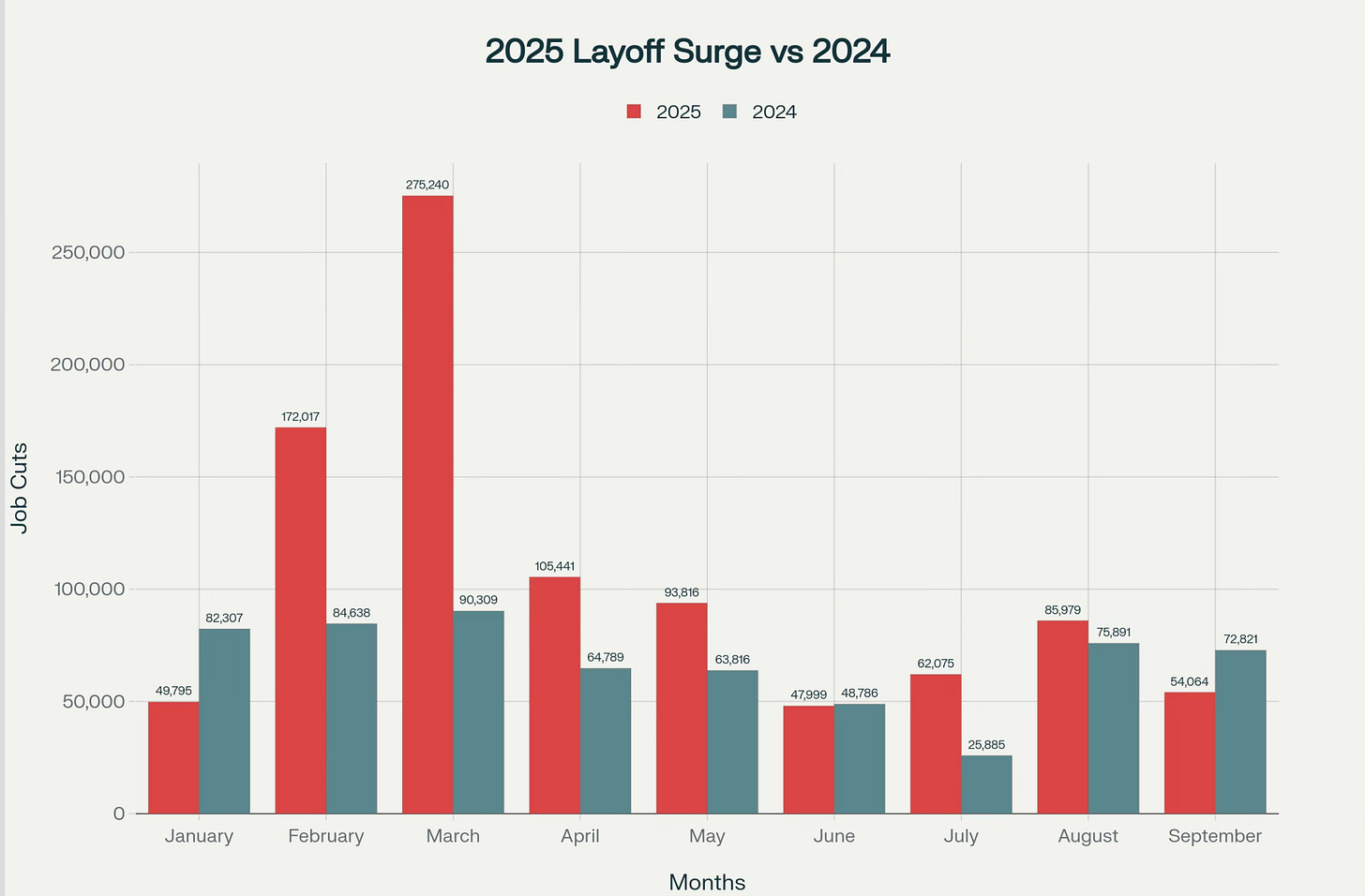
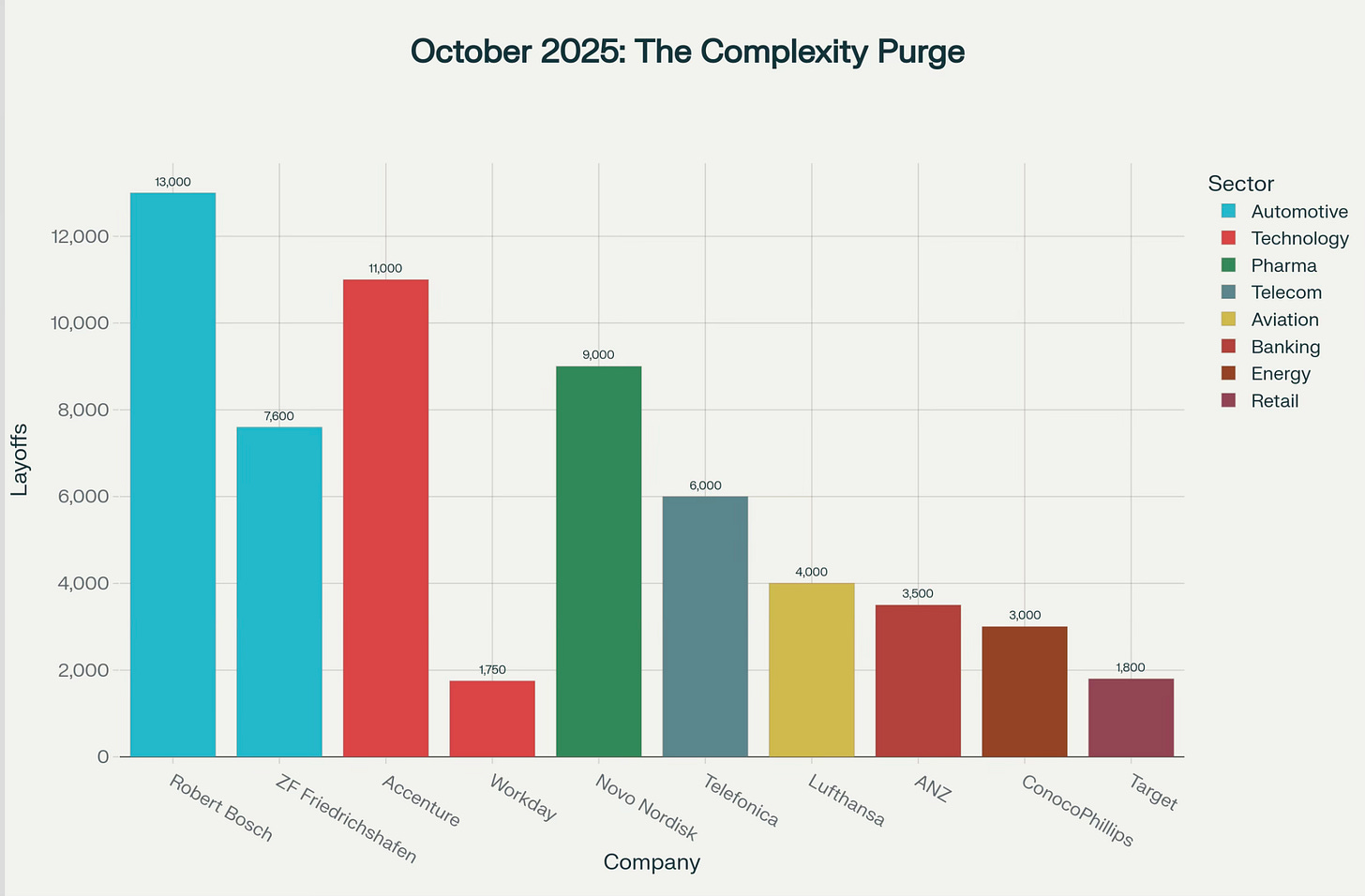
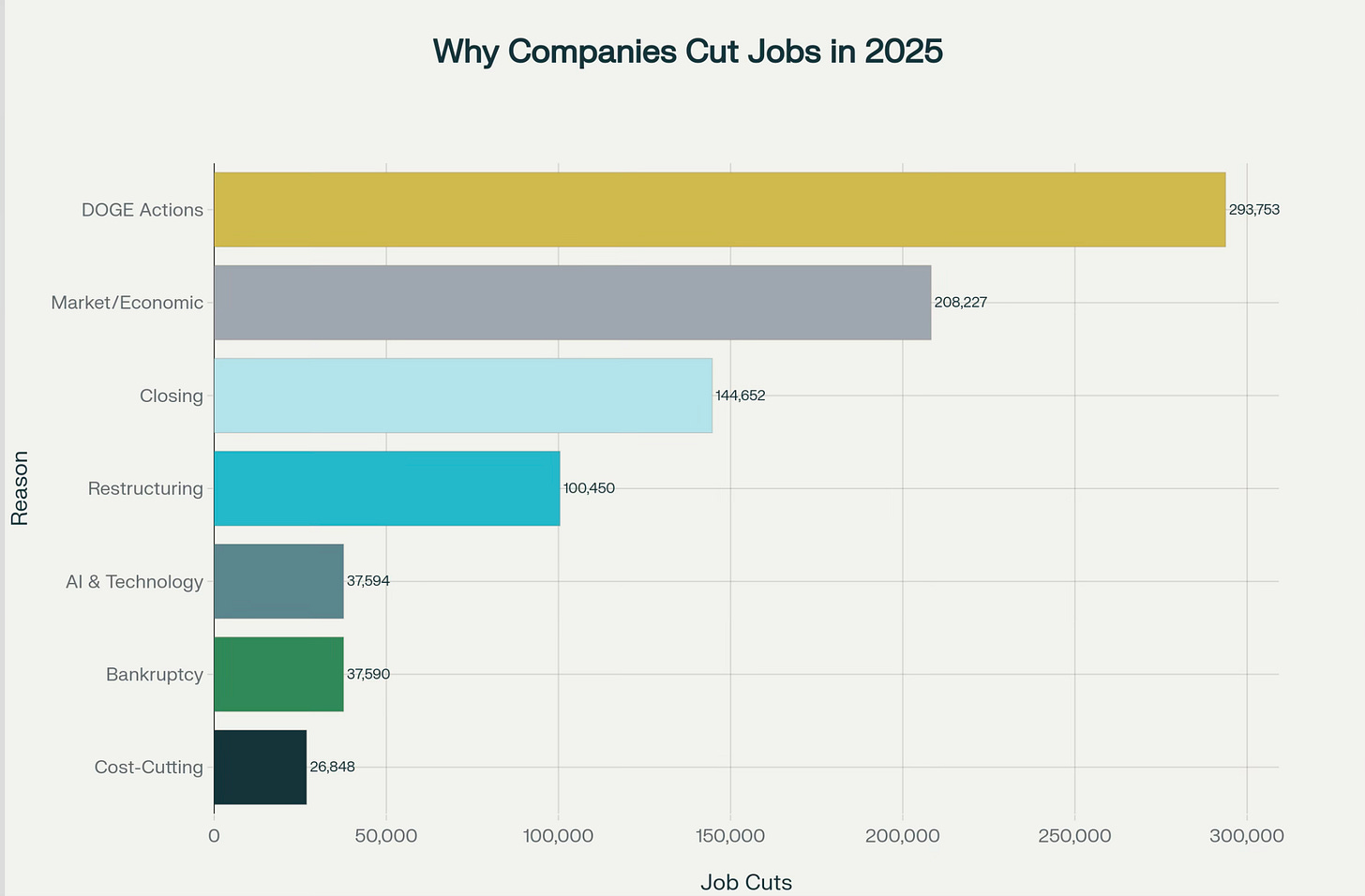
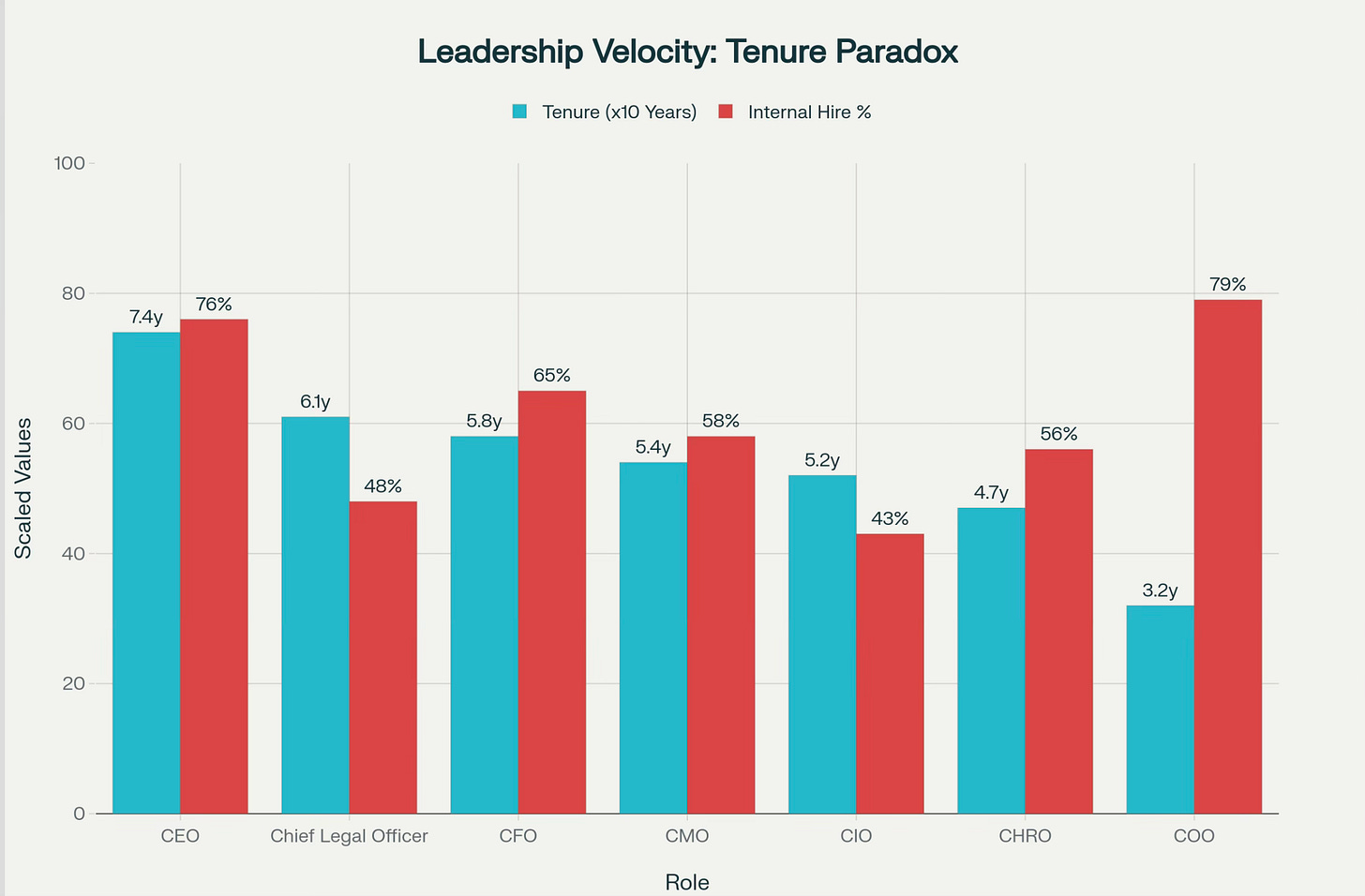
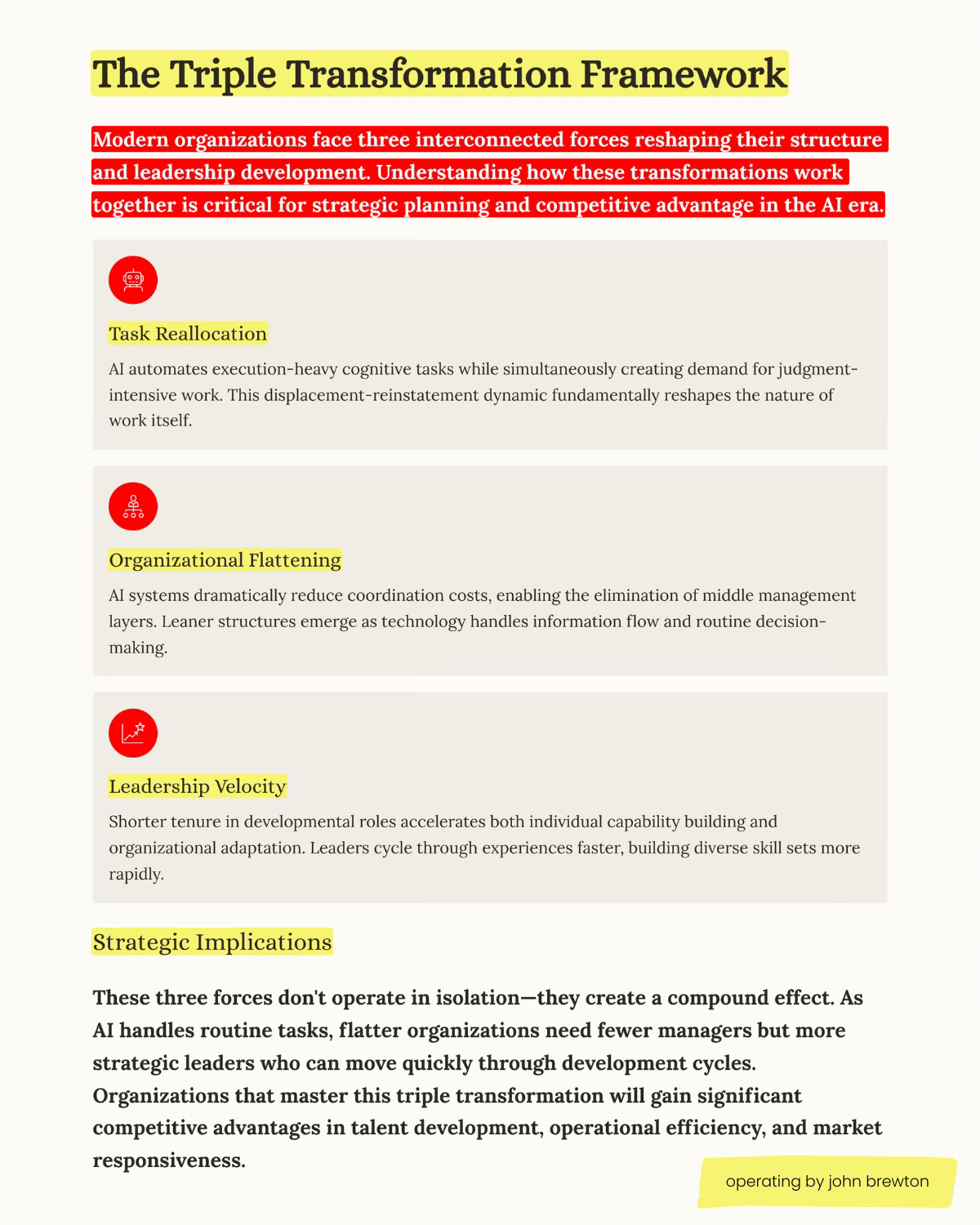
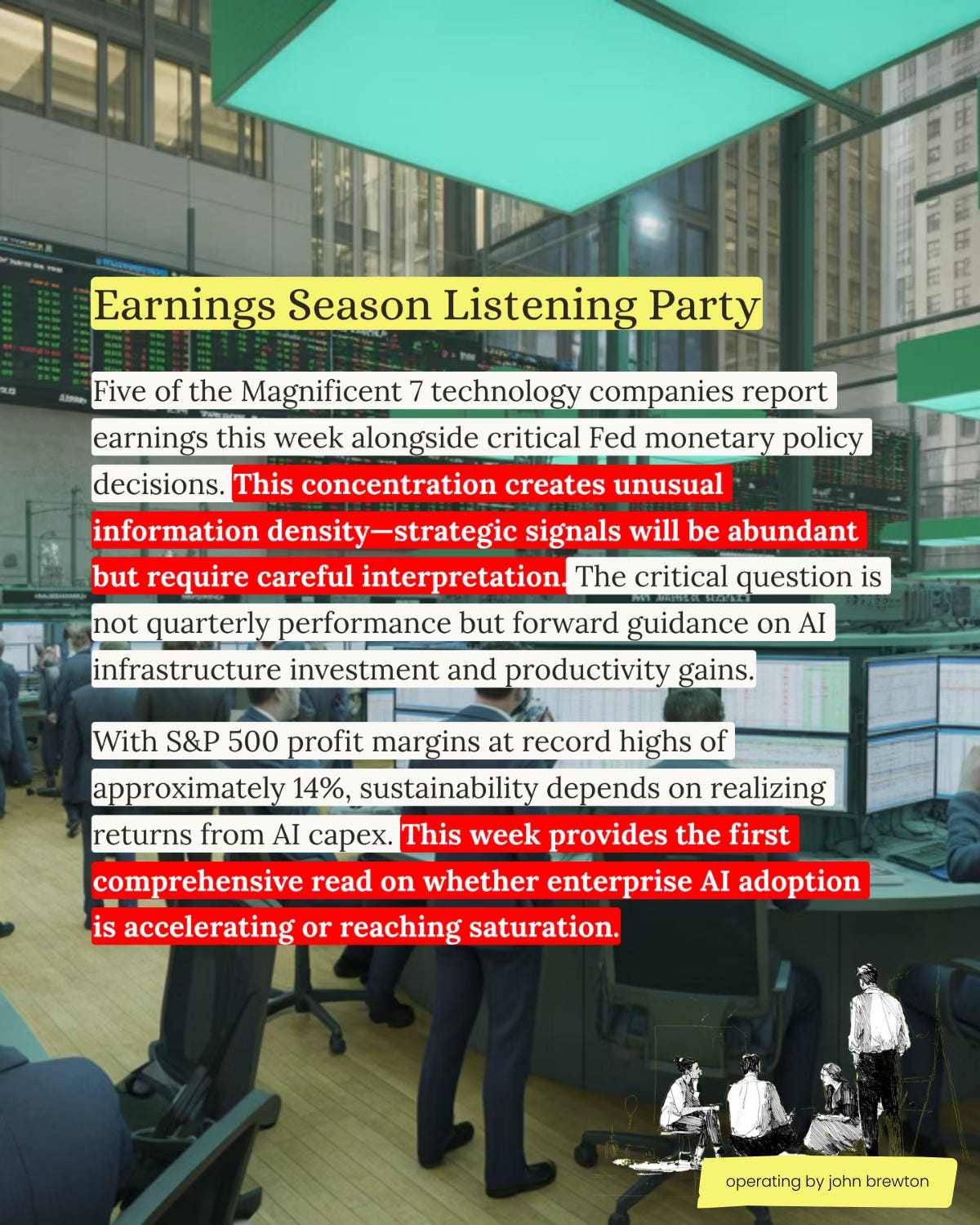
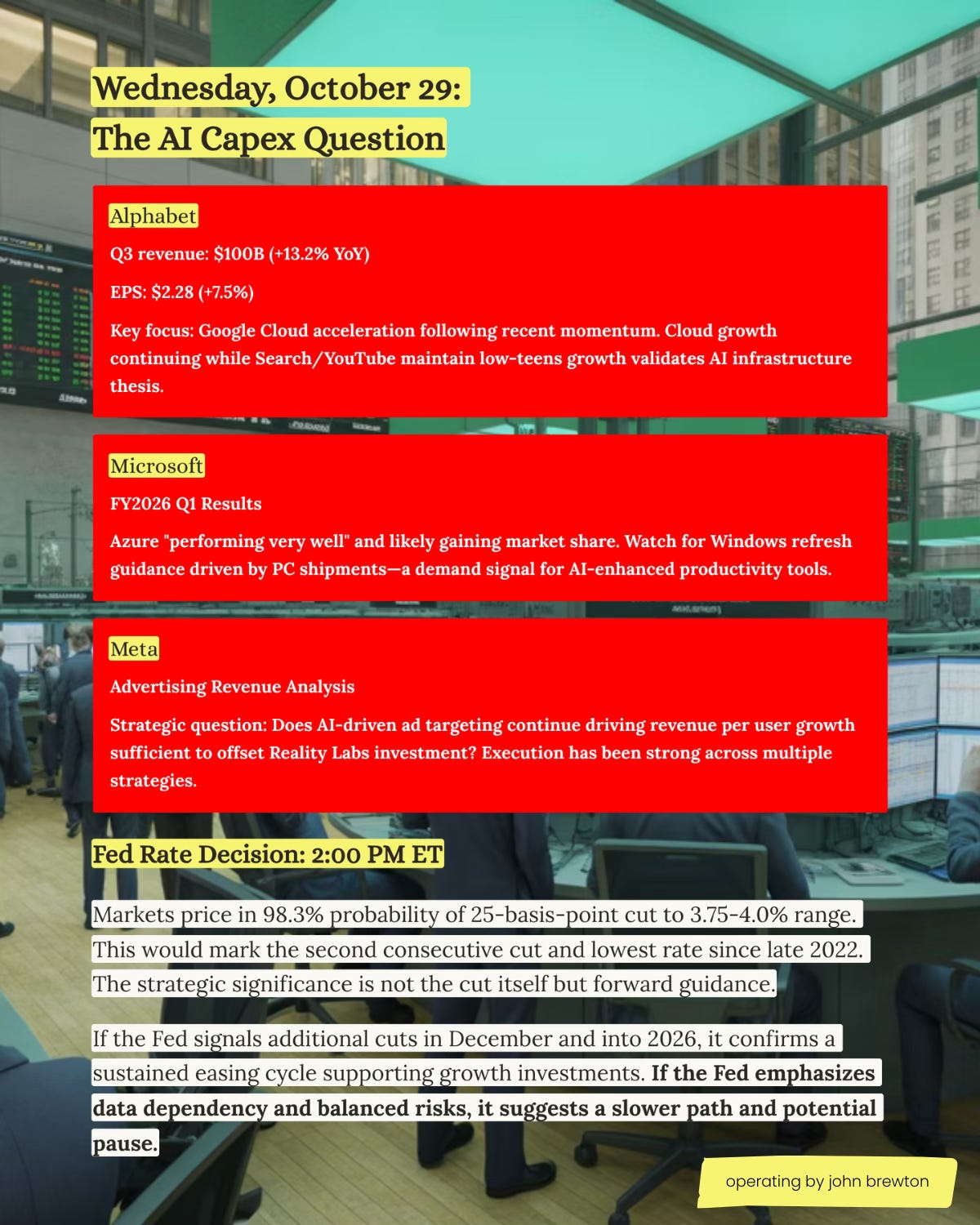
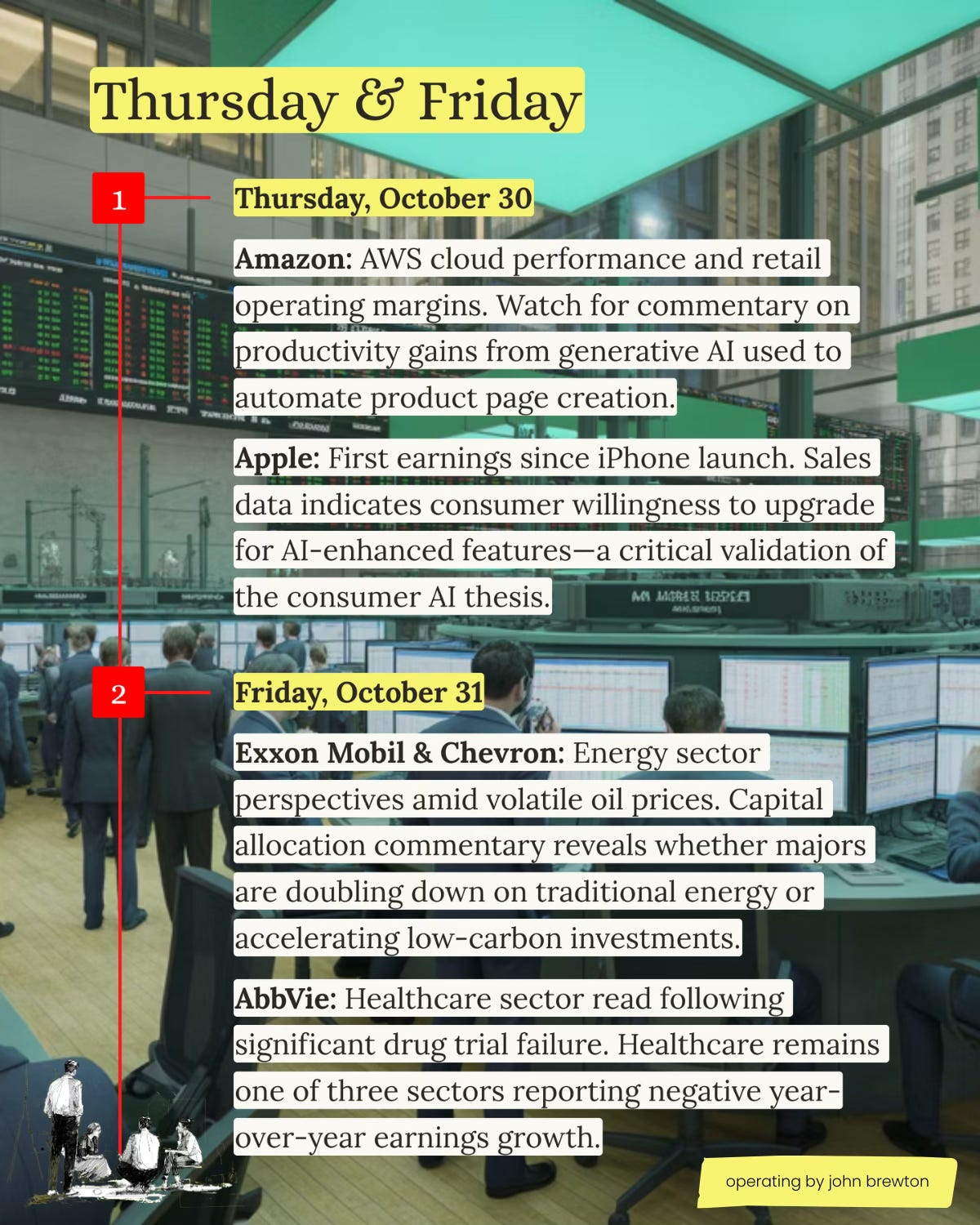
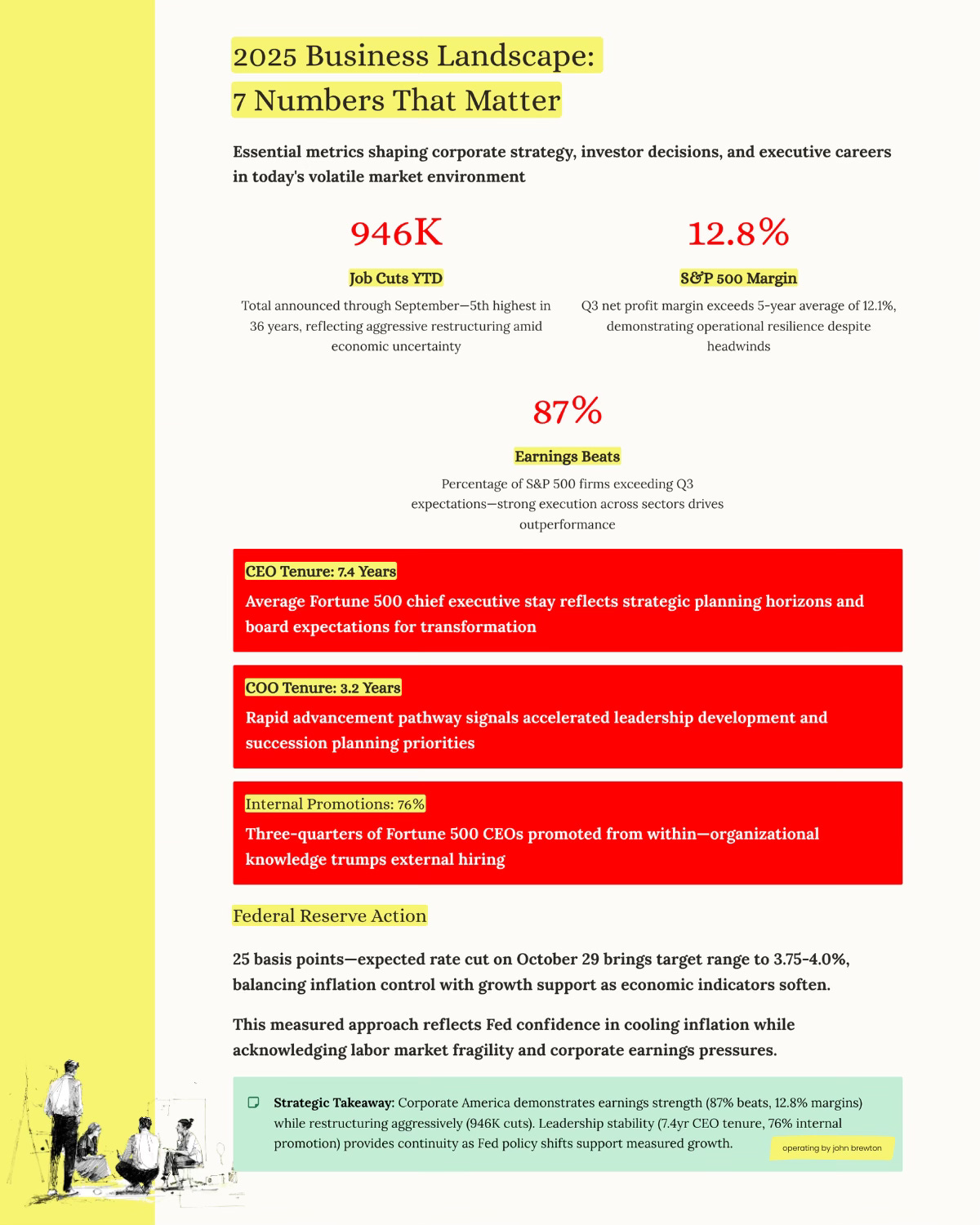
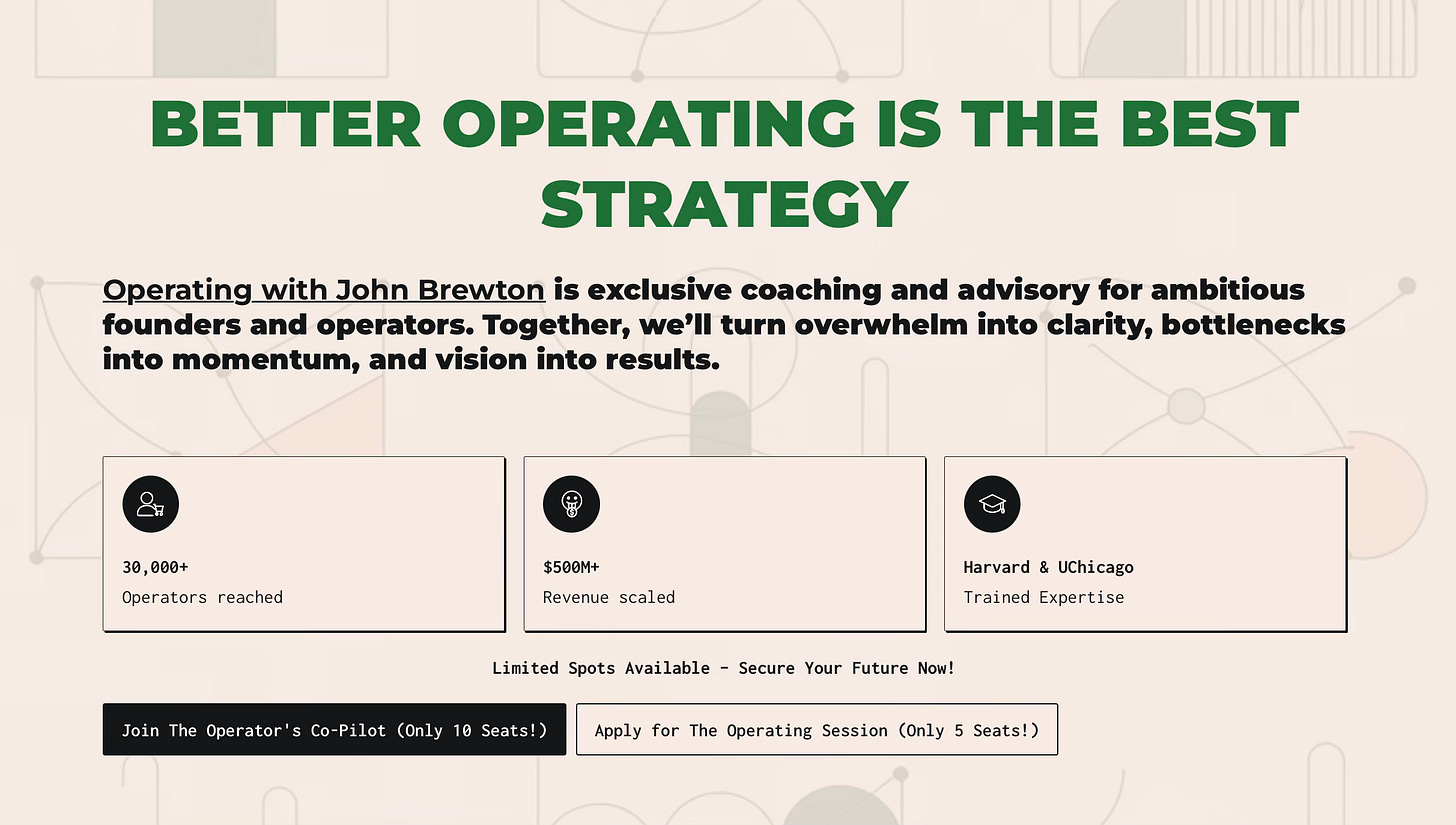

Great piece John- One interesting thought is that all of those company restructurings are being guided by some management consultancy.
Companies like to employ consultancies to do this kind of “dirty work“ because it gives them a “plausible” rationale.
Which justifies firing people just as they’re announcing record profits.
Good work to dig below the surface.